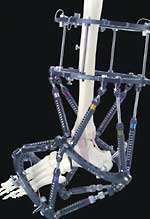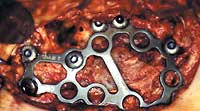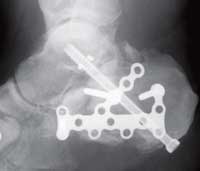Advances in ankle, calcaneal fracture treatment
CAT scans and ORIF revolutionized recognition and management of breaks in the past 25 years.
|
Open techniques still provide the gold standard in treatment for unstable ankle and calcaneal fractures. But today’s methods stem from decades worth of technological advancements and techniques.
Sir Reginald Watson-Jones offered early work on ankle ligament injuries and their treatment by tenodesis after he realized that surgeons often misdiagnosed ruptured lateral ligaments as sprains, said emeritus professor at the University of Glasgow, David L. Hamblen, PhD, FRCS, who trained under the surgeon.
Surgeons had previously thought that muscles protected joints following ligament injury. But Watson-Jones showed that patients who ruptured the lateral ligament following severe inversion injury of their ankle lost the protective sensation of proprioception in the joint. The undiagnosed condition led to chronic recurrent instability in inversion, Hamblen said. Watson-Jones created his tenodesis operation to restore stability. “He took the peroneus brevis tendon and divided it. [He] stitched the proximal end to the peroneus longus so it still worked on the peroneus longus, but took the distal segment, threaded it through a drill hole at the end of the fibula and reattached it. So it actually acted as a new lateral ligament on the lateral side of the ankle,” Hamblen said.
By the 1970s much of the medical community disputed the proper role of open procedures. Surgeons such as Sigvard T. Hansen, Jr. MD, pushed for invasive procedures.
Isadore G. Yablon, MD, brought attention to the importance of the lateral side in reducing fractures. “Now, the teaching at the time was that the medial malleolus was the key and if you put back the medial malleolus, that everything would be alright,” Yablon said, but he noticed a high incidence of ankle arthrosis while treating patients in London. “When I looked at these there was a common denominator,” Yablon said. “In both cases the medial malleolus was repositioned, but they all had an incomplete reduction of the lateral malleolus.” Yablon discovered that patients improved with anatomic restorations of the lateral malleolus. He also later demonstrated that the condition of the medial malleolus did not affect stability. Surgeons only needed healthy ligaments and an uninjured lateral malleolus to restore function.
Recent techniques
The 1990s brought the option of total ankle replacement. “The only treatment we had to date was to fuse the ankle,” Yablon said. Arthrodesis proved difficult and could lead to decreased motion and arthritic developments in other joints, he said.
In the last decade, surgeons adopted percutaneous treatments commonly used for fibula fractures. “We’ve extended the indications towards fractures that are more distal, but still allow for the syndesmosis to be reduced independently of the fibular fracture,” said Paul Tornetta, III, MD, of Boston Medical Center. It also aims to prevent scarring and contamination, he said.
More recent arthroscopic-assisted procedures allow surgeons to evaluate percutaneous reductions as they are performed. “You can actually see [fracture fragments] come together and go inside the joint and say, ‘Yes, it’s reduced,’” said Orthopedics Today board member Carol C. Frey, MD.
Advances in procedures point to a refinement in surgical indications, Tornetta said. Surgeons prescribe operations for unstable ankles, a condition resulting from injured deltoid ligaments. They previously thought that soft tissue swelling was a sign of ligament damage. But recent work by Kenneth A. Egol, MD, and Bruce G. French, MD, disputes this belief, said Tornetta, a member of the Orthopedics Today Editorial Board.
Identification, classification
In the last five years, radiographs provided surgeons with better ways to evaluate fractures pre- and postoperatively. “Stress radiographs have added to our ability to differentiate stable and unstable injuries, thereby allowing the decision for surgical or non-surgical treatment to be based on objective information,” Tornetta said.
|
The technology now constitutes the standard for fracture identification and builds on the work of early pioneers. Bernhard G. (Hardy) Weber developed a classification system based on the fibula. The Danis-Weber classification categorized fractures into A, B and C groups, with simple fractures progressing into more complex breaks. “The Weber is useful only in the A and C types, but the most common B types are not differentiated well,” Tornetta said.
N. Lauge-Hansen also developed a classification system for fractures, which aided surgeons in deciding on the best treatment. The classification described the stance at impact and the direction of the injurious blow. From this information surgeons prescribed the opposing pressure needed to fix the break. Today, surgeons still use the system. “The LH classification is very important,” Tornetta said. “It helps to describe the mechanism of injury and therefore helps to understand the reduction. It also helps to identify the soft tissue, [and] ligamentous injuries, based on the stage of injury.”
Recently developed devices, such as the Taylor Spatial Frame (Smith & Nephew), aid surgeons in the treatment of pilon fractures. “These are very difficult crush injuries to the distal tibia involving the ankle and they’re probably the most challenging of the ‘ankle fractures,’ ” said Orthopedics Today board member Steven Douglas K. Ross, MD. The frame allows surgeons to alter reductions by changing strut length, Frey said. Using the device can also decrease the amount of cut tissue, she said. New locking plates also offer surgeons solutions to length stability and can be used for pilon fractures, Ross said.
Despite advances in technique and implants, surgeons still find that results for ankle replacements do not match those of hips or knees. Expect more intense development of these prostheses in the future, Yablon said. “I think that the thrust now for total ankle replacements is to see which will give good long-term results,” he said.
Exploration of calcaneal fractures
Due to their complexity, calcaneal fracture treatment has long troubled surgeons. “We’ve been doing this for about 15 years, and initially no one really knew if operative intervention would be beneficial,” said Roy W. Sanders, MD, who is the chief of orthopedics at Tampa General Hospital.
“We had not figured out either the appropriate incisions, implants or techniques, and we weren’t really sure about the variety of fractures that we were dealing with.”
Surgeons developed modern operative techniques for the fracture and began to understand the pathology only in the past 25 years or so. Surgeons such as Emile Letournel of France started exploring internal fixation methods for the calcaneus in the late 70s. “Letournel would be one of the pioneers of total fixation,” said James B. Carr, MD, a surgeon with Palmetto Richmond Hospital. “He applied internal fixation of the entire bone to the calcaneus.”
Isaac McReynolds of Houston described medial techniques a decade later. “He observed that if you go in on the medial side, the inside part of the heel, and repaired these two major pieces of the fracture anatomy you pretty much restored the foot to a good appearance and a good shape,” Carr said.
Stephen K. Benirschke, MD, and Bruce J. Sangeorzan, MD, of Harborview Medical Center in Seattle, refined techniques that are considered today’s standards, said Michael P. Swords, DO. “[Benirschke’s] been a pioneer in the extensile lateral approach, which allows you to expose and appreciate the full extent of the injury and that’s probably the main contribution as well as the timing of the surgery and treating the soft tissues with respect,” said Swords, a co-author and orthopedist with Sparrow Health Systems in Michigan.
Minimal procedures
Difficulties with open procedures helped usher in the current wave of minimal approaches. “The biggest problem with this lateral approach [in open procedures] is that you need to make a large flap, and the problem with that is many people have wound problems at the edge of the flap,” Sanders said. The process may also scar the subtalar joint and limit motion. “So when you do these percutaneously, or with minimal incision surgery, then you don’t have problems with the flap and you don’t have problems with the scarring. So these patients tend to have better subtalar motion.”
|
Surgeons such as Tornetta and Carr continue to explore the benefits of minimal operations. Carr said that he uses a 4 cm cut over the subtalar joint on the lateral and medial sides. He reported similar reductions to extensile procedures in 1998. “And we’re not encountering some of the disastrous complications like needing free flaps or people losing their feet and things like that,” he said.
Surgeons previously used the Essex-Lopresti classification mostly to identify which surgical approach to use, Sanders said. The system grouped breaks into two categories and prescribed either percutaneous or open treatment. The popularization of the CAT scan in the 1970s and 80s gave surgeons better views of breaks, leading to more sophisticated classifications. In 1985, David Segal, who was in Boston at the time, incorporated the use of CAT scans with calcaneal fractures, Sanders said
By the early 1990s, Sanders and others developed CAT scan classifications for intra-articular calcaneal fractures and malunions. The system also gave surgeons prognostic information. “So, the simple fractures do better, the more comminuted fractures do worse, and we were able to prove that statistically,” Sanders said.
The development of calcaneal plates posed many problems for stateside surgeons. Letournel designed a calcaneal plate, but it never became available in the United States, Sanders said. Sanders himself created a new plate based on Letournel’s model and the cervical spine H plate used by Diego L. Fernandez, MD of Switzerland. “So I took those two plates and combined them to make the original Synthes calcaneal plate, but that plate had about an 8% failure rate,” Sanders said.
Sanders then constructed the millimeter thick TiMax titanium plate (DePuy) in 1999. “We designed a plate that follows the perimeter of the calcaneus where all the bone is and then we put a strut across it to prevent it from collapsing,” Sanders said.
The future
Today, open reduction internal fixation remains the gold standard in treatment for calcaneal fractures.
Despite new treatments and rehabilitation, the cause of postoperative pain continues to elude surgeons. “… I can fix the bone exactly right on the money and the darn thing still gives the person a bad result,” Carr said. “There’s still something that we don’t understand with the pain mechanism, and I think that would be next, for someone to figure that out.”
Dr. Sanders has a financial interest in a product mentioned in this article and is a paid consultant to DePuy Orthopaedics.



